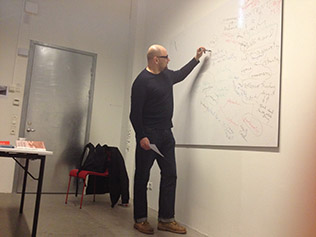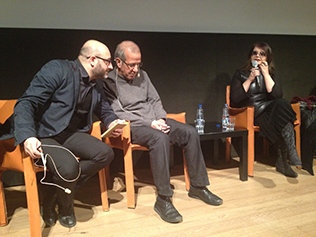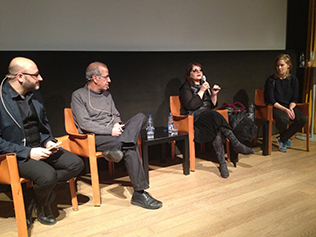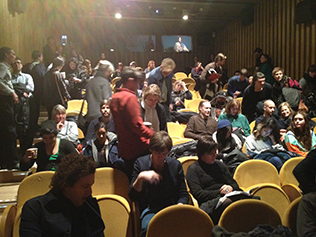2013–2015 har projektet Mikrohistorier (med stöd av Vetenskapsrådet) en central plats i forskningsområdet. Mikrohistorier studerar videoessäns form, vilken kan sägas behandla sina ämnen på ett kritiskt och utforskande sätt samtidigt som den speglar sin process och sina övervägande. Ett kännetecken för videoessäer är att de tar upp ett fenomens detaljer för att visa hur dessa detaljer är en del av ett större sammanhang. Denna upptagenhet av de små, marginaliserade berättelserna delar den med ett historievetenskapligt angreppssätt som kallas mikrohistoria. Här studerar man vanor och rutiner snarare än överlagda handlingar, bakomliggande mentaliteter snarare än uttalade föreställningar. Inom mikrohistoria intresserar man sig för undantaget snarare än regeln, inklusive det alldagliga den förbisedda detaljen – allt detta som kan visa sig lika betydelsefullt som den "stora" erkända historien. I det här projektet sammanförs framträdande praktiker och teoretiker inom dessa tre fält – konst, konstnärlig forskning och mikrohistoria – för att bygga gemensam kunskap. Resultaten ska skapa en brygga mellan olika vetenskapliga förhållningssätt och lyfta fram både en historievetenskap och en konstnärlig genre som blir allt mer betydelsefulla internationellt.
Två offentliga presentationer har genomförts:
March 27, Mandelgren lecture hall, Konstfack, Stockholm.
Magnus Bärtås: “A Short Introduction to Microhistories”
Microhistories gathers knowledge from artistic practice/artistic research and the field of history. The objective is an investigation of how a mutual exchange can come about between the historical perspective/approach used in microhistory, and visual art, especially the video essay genre. Microhistory has been used as a term for the way in which certain historians and writers bring attention to marginalised phenomena and stories and use them prismatically to gain an understanding of larger contexts. The project will explore how this science can be linked to the video essay, as well as to artistic practice in a broader sense.
Magnus Bärtås is an artist, writer and professor of fine art at Konstfack in Stockholm. His dissertation in artistic research You Told Me – Work stories and video essays, examining narrative models in contemporary art and the practice of the video essay, was published in May 2010. Together with Fredrik Ekman he has published three books of essays. Their latest book Alla monster måste dö (2011) was nominated to the Swedish national August prize. Recent exhibitions include “A Postcard from Afar”, apexart, New York, “Bogey”, Miroslav Kraljevic Gallery, Zagreb (together with Lars-Henrik Ståhl), Rencontres Internationales, Palais de Tokyo, Paris and The 9th Gwangju Biennale, 2012. Bärtås is the founder of the research project Microhistories at Konstfack (with support from The Swedish Research Council).
Michelle Teran: ”Folgen”
Teran uses online video as source material for mapping out cities; to interrogate how a narrative language can emerge by revealing a field of relations between digital mapping, social media, the urban landscape and different people living in the city.
Michelle Teran is a Canadian-born artist whose practice explores media, performance and the urban environment. Her work critically engages media, connectivity and perception in the city. Her performances and installations repurpose the language of surveillance, cartography and social networks to construct unique scenarios that call conventional power and social relations into question. Currently she is a research fellow within the Norwegian Artistic Research Fellowship Programme at the Bergen Academy of Arts and Design, 2010-2013.
Behzad Khosravi Noori: “Whisperism – The Field Study of Iranian Filmmakers”
In his talk he will present what he calls the third way of narrativity in documentary films from Iranian filmmakers that have been placed in between two grand narrations in the notion of political and social uncertainty. He is going to present the relational aspect between aesthetics and politics in documentary films, which addresses formal and political matters simultaneously. The artist’s point of view in his talk is not solely the awareness of form but is also the awareness of political form, whereas politics always implies symbolic form. “There is no politics without form, and vice versa.”
Behzad Khosravi Noori is an artists and researcher graduated from Tarbiat Modares university in Tehran in master of motion picture. Since then he has been involved in research and teaching in history of Islamic art in art schools in Tehran. In 2011 he achieved his second master in Art in Public Realm at Konstfack, with the focus of multiple identities within the discourse of European multiculturalism and hyperpoliticized socio environments. He is currently a guest researcher at Konstfack’s department of fine art.
Suzana Milevska: “Microhistories and the Internalized Macrohistories”
In her presentation she will address the rhetorical question whether microhistories could be thought without taking into account the internalized macrohistories. In order to extrapolate how various artists have dealt with the ways in which micro- and macrohistories are mutually entangled and reciprocally affected by each other she will discuss several curatorial projects such as The Little Big Stories, The Renaming Machine and Call the Witness.
Suzana Milevska is a theorist and curator of visual art and culture based in Skopje, Macedonia. She holds a PhD in visual culture from Goldsmiths College-London. From 2010-2012 she taught history and theory of art at the Faculty of Fine Arts – University Ss. Cyril and Methodius of Skopje. From 2006 to 2008, she was the Director of the Center for Visual and Cultural Research at the Euro-Balkan Institute in Skopje and she taught Visual Culture at the M.A. Programme in Gender Studies. Her long term interdisciplinary project “The Renaming Machine” (2008-2010) consisted of series of exhibitions and conferences (Ljubljana, Skopje, Pristina, Zagreb, Vienna, etc.) and the book The Renaming Machine. She published the book Gender Difference in the Balkans (Saarbrucken: VDM Verlag, 2010). She was a researcher for the project “Call the Witness – Roma Pavilion”, at the 54 International Art Exhibition –Venice Biennale-Collateral Event, 2011 and curated the exhibitions “Call the Witness”, BAK, Utrecht, and “Roma Protocol” at the Austrian Parliament. In 2012 she won the Igor Zabel Award for Culture and Theory and the ALICE Award for political curating.
Lena Séraphin: “The Don Quixote Complex”
The aim of Lena Séraphin’s talk is to present a collaborative process leading towards an epistolary novel. The novel itself consists of a decade-long correspondence, drawings and photographs. She reflects on the novel as a mode to rapport artistic research and how this particular form of communication will affect the construction of understanding.
Lena Séraphin is an artist and Doctoral Candidate at the Aalto University School of Arts, Design and Architecture in Helsinki. She has graduated from Goldsmiths College, London in 1997 and UIAH, Helsinki in 1998. Her doctoral thesis Fictum is based on artistic research and investigates the potential of fictionality. She has worked as a contributing editor for Hufvudstadsbladet between 2003 and 2005. Her radioessay “The Life-Thirsting Shadow” was broadcasted in 2013 for YLE. She has worked as director for the Institute of Fine Arts, Lahti University of Applied Sciences between 2005 and 2007. The exhibition “Lena Séraphin, Andrea Meinin Bück & Don Quixote Complex” was shown at the Kluuvi Gallery, Helsinki Art Museum in 2011. Forthcoming; “The Fiction Show” at Tramshed Gallery, London in 2013. “The Fiction Show” is preceded by “The Fiction Issue” of the Art & Music Magazine.
Lina Selander: “Lenin’s Lamp Glows in the Peasant’s Hut”
The elements of Lenin’s Lamp equally reject an idea of films, photographs or videos as neutral accretions of visual information. The elements of this film are to be seen both as material witnesses of the experience of modernisation and as agents of the very same history. From Dziga Vertov’s film The Eleventh Year (1928) to and video recordings from the Chernobyl disaster and the ghost city of Pripyat to images of fossils in museums and prehistorical landscapes, Selander’s images consist of sensory materials. Lina Selander offers a subtle meditation on the long-term historical effects provoked both socially and ethically by the Soviet utopia of the production of energy, summarised in Lenin’s slogan from 1920: “Communism is Soviet Power plus the electrification of the whole country”.
Lina Selander works mainly with moving images in film and video, but also with photography, text and sound. Her works are often installations where these different medias and components converge and interrelate to one another. She is interested in the image’s ability and lack of ability to reproduce time, experience and memories and she explores how different narrative forms and techniques transform and change a story. Her works investigate film as medium, examining its possibilities and limitations as form of expression, and they often raise questions about history and authenticity. Selander’s work has been shown at Index, The Swedish Contemporary Art Foundation, Moderna Museet and and in international group shows, biennales and festivals, for example in the Manifesta 9-European Biennal of Contemporary Art 2012 and the Bucharest Biennale 2010.
Narrative processes / Microhistory
Monday 10/2: Open lecture at Konstfack S 2
11.00 – 11.45: Mika Hannula: CONTENT OF THE FORM
- Narrative Structures and Why Do They Really Matter
The talk will focus on the theme of narrative understanding of oneself – both seen from the personal and the collective perspective. I will outline the basic elements and components of narrative structures that have been used especially in self-reflective writing, analyzing either historical issues or matters at hand. The talk will articulate the reasons why these narrative structures matter and how they actively affect our processes of self-understanding.
I will concentrate on two writers relevant for the field: the historian//philosopher Hayden White and the philosopher//semiotic Paul Ricoeur. From White, besides the title of the talk (content of the form referring to the fact how a chosen structure and type of a narrative is not neutral, not just formal, but value-laden and content formative), I will address the four-part and level structure of narrative representation and emplotment (romance, tragedy, satire and comedy), following up with the consequent ideological four-part forms (anarchy, conservative, radical and liberal) With Ricoeur, the focus is both on the basic structure of narratives, what do they do and how our lives are embedded, in fact, only comprehensible as narratives.
The talk will end with a case arguing for the relevance of a narrative structure of self-understanding, focusing on the comparison between the collective self-understanding of the former DDR and West-Germany and their respective types of narratives which form the modes of tragedy and irony.
Tuesday 11/2: Lectures and film programme
Location: The cinema, Moderna Museet, Stockholm
Language: English
Welcome to a full-day seminar of the interdisciplinary research project Microhistories at Konstfack in collaboration with IASPIS and Moderna Museet
Video essays have the ability to capture details or phenomena and show how they relate to a larger context. This orientation is shared by the discipline of scientific historiography called microhistory. Just like the filmic essay, the discipline studies habits and routines rather than deliberate acts: an interest in underlying mentalities rather than expressed conceptions.
Artists, theoreticians and historians who work with microhistorical issues participate in the seminar. Film screenings, discussions and lectures will explore the exception rather than the rule, including everyday, overlooked details – which may turn out to be as important as the “grand” established history.
The film programme gathers works that relate to microhistory, in which the positions of the text and the narrator play decisive roles.
PROGRAMME:
10.00 – 10.15 Brief introduction by Magnus Bärtås, visual artist and writer
10.15 – 10.45 “Ginzburg as essayist” – lecture by Andrej Slávik, historian
11.00 – 12.00 Film programme, part 1
Cacheu by Filipa César
Dad’s Stick by John Smith
Off-white Tulips by Aykan Safoğlu
Les mains négatifs by Marguerite Duras
13.00 – 14.45 Film programme, part 2
Branden by Staffan Lamm – with an introduction by Staffan Lamm
In the Year of the Quiet Sun by The Otolith Group
Jag drömde om att flyga flera kilometer med skidorna by Cecilia Nygren
15.15 – 15.45 “Micro narrativity in the Iranian context”, lecture by Behzad Khosravi Noori, visual artist
15.45 – 16.15 Reading Salinger in Teheran by Pirooz Kalantari, film-maker
16.15 – 17.00 Discussion with Pirooz Kalantari and Cecilia Nygren led by Suzana Milevska
On Andrej Slávik’s lecture
Microhistory, as a distinct approach to scientific historiography, grew out of wider post-war concerns about the failings of Western modernity while also contributing to the overarching project of a “history from below”. Spearheaded by a group of Italian historians, it gained momentum during the ‘70s and received its international breakthrough in 1980, when Carlo Ginzburg’s The Cheese and the Worms was first translated into English. The book has since appeared in over two dozen languages, making microhistory – or at least Ginzburg’s take on it – a truly global academic phenomenon. In his lecture, Andrej Slávik will discuss a few aspects of Ginzburg’s writings that are relevant to the Microhistories project, with the essay as a common focus.






